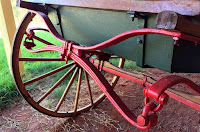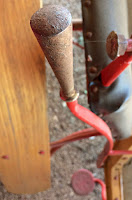For many years he would be seen at the annual ‘Action Day’ event each Good Friday working on the wheelwright outside the blacksmith display to construct wheels for his many carriages.
These carriages are now part of the Museum’s collection and there are plans to build a permanent home for them during 2017.
Mr Todd lived for almost his entire life at Lake Wyangan, where his father Keith Todd purchased the first block of land and also the first irrigated water available in that district.
When Ian Todd died on 20 February 2010 his bequest to Griffith City Council directed they erect “a water trough with a plaque suitably inscribed to the memory of the horses used to develop the town of Griffith and the Murrumbidgee Irrigation Area”. This sits outside Council’s chambers.
Furthermore, Mr Todd donated a number of horse vehicles and vintage automobiles to Griffith Pioneer Park Museum with funds to be used to construct a shed to house these donated items.
It is anticipated that “Todd’s Shed” will be constructed during 2017.
Early 20th Century vehicles
Horse-drawn vehicles were a common sight on public roads throughout Australia from European settlement up until the 1930s.
The company Tarrant began manufacturing cars in Australia in 1901, before acquiring rights to locally produce the T-model Ford from 1909.
Between 1911 and 1916 the number of motor vehicles in New South Wales quadrupled, from 3978 to 14,973.
A survey of Sydney traffic in 1923 found:
- 39.2% horse driven
- 33.8% car
- 27% motor van
Sydney Sulky
These single-seater carriages were designed to be fast vehicles.
Contemporary harness-racing carts can be seen as a modern evolution of their design.
The bulk of the surviving “gigs” and “sulkies” were produced between 1890-1930. The Sydney Sulky is recognised as the most popular style of vehicle.
The Sydney Sulky design was influenced by the American “Putnam” sulky, which was first registered as a design around 1884.
At the 1893 Sydney Show a sulky of this style with mudguards and dashboard was exhibited and the example shown here reflects these features.
Other features to note:
Rubber tyres — these first became available in the early 1900s.
Lamp holders — located on this sulky out of the line of sight of the driver.
Three-spring suspension — reduces bumps while travelling and an improvement on the elliptical suspension of earlier carriages.
Foot-operated bell — manufactured in New York but locally installed and would have been used to alert pedestrians and other road users.
Drop Front Phaeton
Phaeton carriages were drawn by one or two horses.
The name Phaeton comes from Greek mythology as the name of the son of Helios, who drove the Chariot of the Sun so recklessly that Zeus struck him down with a lightning bolt to prevent him from destroying the Earth with fire.
Phaeton was first used to identify a carriage in 1735 by the French during a period when it was fashionable to use classical pseudonyms. The name was applied to large and small owner-driven carriages, which usually included some sort of top that would shelter at least the driver.
Drop Front Phaetons were popular from 1850s up until the 1920s. The lowered front made these carriages easier for women wearing long dresses.
Other features to note:
Lamp holders — placement suggests illumination was to be seen by other road users.
Hand-operated brake — effective in conjunction with horses stopping and primarily used for parking.
Elliptical suspension — popular on 19th Century carriages and effective for rough terrain.
Iron-rimmed wheels —durable and commonly used up until the availability of rubber and then pneumatic tyres.












